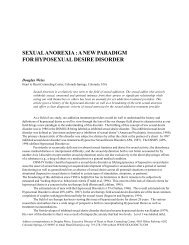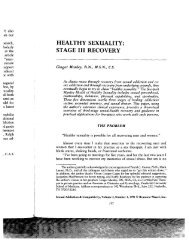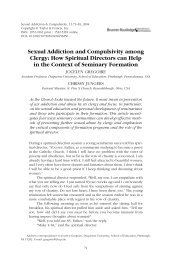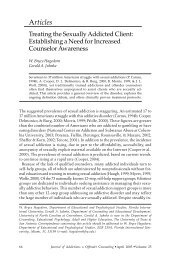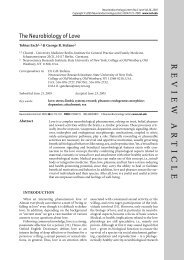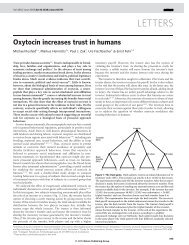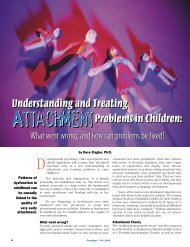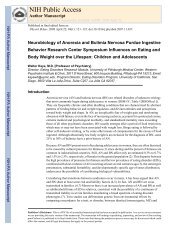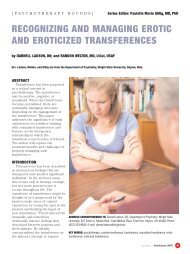Professional Boundaries PP.pdf
Professional Boundaries PP.pdf
Professional Boundaries PP.pdf
Create successful ePaper yourself
Turn your PDF publications into a flip-book with our unique Google optimized e-Paper software.
<strong>Professional</strong> <strong>Boundaries</strong>:<br />
‘Staying in the Zone of Helpfulness’<br />
Jeff Kirby, MD, MA(Phil)<br />
Associate Professor<br />
Department of Bioethics<br />
Faculty of Medicine<br />
Dalhousie University<br />
Overview<br />
• Introduction – infamy/quotes<br />
• Definitions and terms<br />
• <strong>Professional</strong> guidance documents<br />
• A little theory<br />
• Selected boundary topics<br />
• Variety of interactive cases<br />
Infamous NS sexual misconduct case<br />
(late 1990s)<br />
• ‘Dr. B’<br />
• Practiced family medicine in Barrington<br />
Passage for 35 years<br />
• Had a sexual relationship/affair with a<br />
psychotherapy patient which was reported to<br />
the College of Physicians and Surgeons by a<br />
professional colleague<br />
• Delegation of municipal officials presented<br />
4,000-name petition from area residents in an<br />
attempt to maintain Dr. B’s practice<br />
1
Infamous NS sexual misconduct case<br />
• ‘Dr. B’<br />
• Victim, Ms. H., went public with her opinion<br />
that her affair with Dr. B. was consensual and<br />
that the College’s interference was<br />
unwarranted<br />
• College revoked Dr. B’s license and released<br />
the content of the settlement agreement to the<br />
public, which contained intimate details of the<br />
sexual relationship and portrayed Ms. H. as “a<br />
deeply disturbed woman”<br />
A few quotes…<br />
• “I will enter only for the good of my<br />
patients keeping myself far from all<br />
intentional ill-doing and all seduction, and<br />
especially from the pleasures of love with<br />
women or with men.”<br />
Hippocratic Oath (circa 1600 B.C. to 100 A.D.)<br />
2
• “Medicine is a play of boundaries.”<br />
Frank<br />
• [<strong>Professional</strong> boundaries] “may be<br />
defined as the expected and accepted<br />
psychological, social, and physical<br />
distances between a professional and<br />
his/her patient.”<br />
Donen<br />
• “<strong>Professional</strong> boundaries are the dividing<br />
lines which separate the therapeutic<br />
behavior of a professional caregiver from<br />
any behavior which, well intentioned or<br />
not, could reduce the benefit of care or<br />
treatment to patients, clients, families and<br />
communities.”<br />
Thibeault<br />
3
• “Like geographical boundaries,<br />
relationship boundaries involve issues of<br />
power, influence, and control. Unlike<br />
geographical boundaries, which are<br />
usually demarcated with precision and<br />
clarity, relationship boundaries are often<br />
blurred and ambiguous.”<br />
Bergum, Austin, et al.<br />
• Consider whether the ‘boundary<br />
metaphor’ does sufficient work in this<br />
context<br />
Terms…<br />
• Boundary crossing<br />
• “Crossings as excursions across the lines<br />
demarcating the professional<br />
relationship. A crossing … is not harmful<br />
nor exploitive and possibly has a<br />
therapeutic purpose.”<br />
Austin, Bergum et. al<br />
4
Terms…<br />
• Boundary violation<br />
• “A violation … is clearly harmful (or<br />
exploitative) and puts the client, the<br />
professional, and the therapy at risk. It<br />
is usually a situation where the<br />
professional’s own needs are placed<br />
ahead of the client’s.”<br />
Austin, Bergum et. al<br />
• Determining where the boundaries lie is<br />
difficult in many circumstances…<br />
• Guidance is available for some<br />
boundary questions<br />
• For example, established professional<br />
codes of ethics<br />
5
CMA Code of Ethics (revised 2004)<br />
• “Consider first the well being of the patient.”<br />
• “Resist any influence or interference that<br />
could undermine your professional integrity.”<br />
• “Take all reasonable steps to prevent harm to<br />
patients.”<br />
• “Do not exploit patients for personal<br />
advantage.”<br />
• “Seek help from colleagues and appropriately<br />
qualified professions for personal problems<br />
that might adversely affect your service to<br />
patients, society or the profession.”<br />
CNA Code of Ethics<br />
for Registered Nurses<br />
• “Nurses maintain appropriate professional<br />
boundaries and ensure their relationships<br />
are always for the benefit of the persons<br />
they serve. They recognize the potential<br />
vulnerability of persons and do not exploit<br />
their trust and dependency in a way that<br />
might compromise the therapeutic<br />
relationship. [They] do not enter into<br />
personal relationships (romantic, sexual or<br />
other) with persons in their care.”<br />
NS Association of Social Workers Code<br />
of Ethics and Standards of Practice<br />
• Value 4: Integrity of <strong>Professional</strong><br />
Practice<br />
• “It is the responsibility of social workers<br />
to establish the tenor of their<br />
professional relationships with clients,<br />
and others to whom they have<br />
professional duty, and to maintain<br />
professional boundaries.”<br />
6
Social workers’ code of ethics<br />
• 3.2 <strong>Professional</strong> boundaries<br />
• “In establishing a relationship with<br />
appropriate professional boundaries, the<br />
social worker shall:<br />
• Acknowledge the place of privilege he or she<br />
holds in all professional relationships, with<br />
the potential for harm to others should that<br />
privilege be misused<br />
• Take care to responsibly manage all<br />
parameters of authority and to act to<br />
protect clients from undue influence and<br />
abusive use of power or expert position.”<br />
<strong>Professional</strong> guidance…<br />
• Directions provided by professional codes<br />
of ethics/conduct are usually rather vague<br />
• ‘Rules’ will only get us so far<br />
• Importance of context: in addition to<br />
actions, we need to consider values,<br />
intentions/motivations, consequences,<br />
vulnerabilities, etc.<br />
A little theory…<br />
7
• Trust<br />
• Understood in the health care context as<br />
the reliance and related expectation that<br />
health organizations and those working<br />
within them will act so as to put the<br />
interests of patients first<br />
• The earning and maintenance of the<br />
public’s trust is an important moral<br />
obligation of health organizations<br />
• Fiduciary relationships<br />
• Characterized by power imbalances in<br />
knowledge and (usually) status =<br />
potential vulnerability for<br />
patients/clients<br />
•Trust-based<br />
• Predicated on ethics principles of<br />
beneficence and nonmaleficence<br />
• The therapeutic continuum<br />
• An optimal therapeutic relationship<br />
between a health care provider (HCP)<br />
and a patient/client operates within a<br />
‘zone of helpfulness’ between two ‘harm<br />
end-zones’:<br />
• Under-engagement – distant/cold relations<br />
• Over-engagement – potential boundary<br />
violation<br />
8
IWK Health Center Research<br />
<strong>Professional</strong> boundaries in relationships<br />
with patients and families<br />
Jeannie Hughes and Cathy Walls (p. investigators)<br />
• Interviewed 27 health professionals<br />
• Eight everyday tensions revealed and<br />
described that require safe and appropriate<br />
negotiation<br />
Everyday tensions<br />
• Intimate care – providing empathetic,<br />
compassionate care vs. remaining personally<br />
disconnected<br />
• Family-centred care – buttress or barrier<br />
• Multidisciplinary team approaches – concord<br />
vs. discord<br />
• Experience/expertise vs. rules and guidelines<br />
Everyday tensions<br />
• <strong>Professional</strong> responsibility vs. collegial loyalty<br />
• Role clarity: delineating personal and<br />
professional roles<br />
• Personal disclosure – relationally beneficial<br />
vs. injurious<br />
• Gift-giving/receiving – appreciation vs. abuse<br />
9
Selected boundary topics<br />
• Interactions between HCPs and<br />
patient/clients<br />
• Social boundaries<br />
• Personal disclosure<br />
• Sexual boundaries/misconduct<br />
• Under-engagement<br />
• Interactive relations/boundaries between<br />
HCPs<br />
• Conflicts of interest<br />
Interactions between HCPs<br />
and patients/clients<br />
Boundary crossing warning signs<br />
• HCP feels ‘connected’…<br />
• Has frequent thoughts of patient/client<br />
when away from work<br />
• Shares personal information or work<br />
concerns with patient/client<br />
• Feels responsible for the patient/client and<br />
his/her progress<br />
• Keeps secrets with patient/client<br />
10
Warning signs<br />
• HCP ‘cares more’…<br />
• Pays more attention or provides more<br />
treatment services to one patient/client<br />
than another in the same circumstances<br />
Warning signs<br />
• HCP interacts socially…<br />
• Changes/upgrades dress style when<br />
patient/client is on the daily list<br />
• Gives and receives gifts<br />
• Arranges social contact while or after<br />
the professional relationship is active<br />
Social boundaries<br />
11
Case…<br />
Elizabeth, an audiologist with the H&S<br />
Clinic, has been providing treatment<br />
services to Jane, the clinic secretary, who<br />
has progressive, bilateral hearing loss.<br />
Jane appreciates the way Elizabeth makes<br />
an effort to fit her in between clients when<br />
she’s experiencing hearing difficulties.<br />
Jane brings a wrapped gift for Elizabeth to<br />
the clinic.<br />
What should Elizabeth do<br />
Case…<br />
• Ken has been seeing Dr. Reserved, a<br />
female psychiatrist, on a regular basis for<br />
the past year for management of his<br />
major depressive disorder. Both are<br />
pleased with his progress and decide<br />
together that further visits will be on an<br />
open-ended, as required basis. On the<br />
way out the door, Ken puts out his arms<br />
to hug Dr. Reserved.<br />
What should she do<br />
Case – modified…<br />
• What if Ken has a severe personality<br />
disorder and it is anticipated that he<br />
will require long term follow-up with<br />
Dr. Reserved<br />
12
Personal disclosure<br />
Case…<br />
• Dr. George Empathy has seen Shelly in his<br />
office on five occasions. They have developed<br />
a good therapeutic alliance and she has<br />
benefited somewhat from education<br />
regarding her panic disorder. Although Shelly<br />
remains dysfunctional on the basis of<br />
frequent panic attacks and agoraphobia, she<br />
is resisting a recommended trial of SSRI<br />
antidepressant medication. Dr. Empathy also<br />
suffers from panic disorder and his<br />
symptoms responded well to pharmacological<br />
management. Is it ok for him to disclose his<br />
experience of his psychiatric condition to<br />
Shelly to encourage her to try the<br />
medication<br />
• Epstein study of 500+ psychiatrists –<br />
17% disclosed personal details to<br />
patients “to impress them”<br />
• Research suggests that the move<br />
toward a sexual encounter often begins<br />
with self-disclosure (slippery slope<br />
argument)<br />
13
Case: Kira and Bradley<br />
Sexual boundaries/misconduct<br />
Sexual misconduct<br />
• One definition…<br />
• Sexual misconduct is any behaviour,<br />
gesture or expression that is sexualized,<br />
seductive or sexually demeaning to a<br />
patient/client.<br />
14
Sexual misconduct<br />
• Conception of sexual misconduct as a<br />
spectrum of actions…<br />
•Voyeurism<br />
• Examination in presence of learners, without<br />
consent or after consent withdrawn<br />
• Sexual comments about patient’s body/clothing<br />
• Inappropriate comments re. sexual orientation<br />
• Requesting inappropriate details re. patient’s<br />
sexual behavior<br />
• Comments re. patient’s potential sexual<br />
performance<br />
Sexual misconduct<br />
• Spectrum of actions…<br />
• Conversation re. sexual preferences and<br />
fantasies<br />
• Inappropriate examination, e.g., body area<br />
examined not relevant to presenting complaint;<br />
without gloves, etc.<br />
• Inappropriate body contact, including ‘hugging<br />
of a sexual nature’ and kissing<br />
• Touching/massaging a sexualized body part<br />
• Physician-patient sexual relations<br />
College of Physicians and<br />
Surgeons of Nova Scotia<br />
• Sexual Misconduct in the Physician-<br />
Patient Relationship Policy<br />
• “Sexualizing the physician-patient relationship<br />
has no therapeutic value … patient consent is<br />
never an acceptable rationalization … the<br />
physician must set and control the limits.”<br />
i.e., no such thing as consensual sex between<br />
a physician and his/her patient<br />
15
The perpetrators…<br />
• Typical profiles of health professionals<br />
who violate sexual boundaries:<br />
• Not too smart/sophisticated/informed HCPs<br />
• ‘Burnt out/cooked’ and lonely HCPs<br />
• Sociopathic HCPs<br />
Robinson<br />
• Is it ever acceptable to have a<br />
sexualized relationship with a<br />
patient/client<br />
Case…<br />
Dr. Jim Onlythelonely, a newly graduated<br />
family doctor, has recently moved to a rural<br />
area for a job opportunity at a small<br />
community health centre in Nova Scotia. One<br />
of his “inherited” patients is a woman, Sue, of<br />
about his own age. He has seen her at the<br />
clinic on a few occasions for the investigation<br />
and management of routine health concerns.<br />
After being in the community for about six<br />
months, Jim meets Sue at a ‘kitchen’ party.<br />
He’s been lonely and he’s aware that Sue is<br />
one of the few women in the community who<br />
are not partnered. At the end of the evening,<br />
Sue suggests they meet for coffee next week.<br />
Should he go<br />
16
Case – modified…<br />
• What if one of Sue’s routine visits to the<br />
community health centre was for a Pap<br />
smear and breast examination<br />
Case – modified…<br />
• What if Dr. Onlythelonely is a<br />
psychiatrist who has seen Sue on two<br />
occasions at the community health<br />
centre for evaluation and treatment of<br />
a depressive disorder<br />
• What are relevant factors to consider<br />
• Nature and duration of the therapeutic<br />
relationship<br />
• Degree of vulnerability – the more<br />
vulnerable the patient/client, the more<br />
rigid the compliance with boundary<br />
guidelines/prohibitions needs to be<br />
17
• Is psychiatric care/psychotherapy a<br />
special case<br />
• “The nature of psychotherapy poses special<br />
problems, one of which is the idealization and<br />
erotic valuation of the therapist.”<br />
• “Some psychotherapy has as a central feature<br />
the management of transference and<br />
counter-transference”<br />
Canadian Psychiatric Association’s Position on<br />
Sexual Exploitation of Patients<br />
Ontario’s situation<br />
• The College of Physicians and Surgeons of<br />
Ontario has a strict ‘zero tolerance’ policy<br />
regarding sexual relations between<br />
psychiatrists and their former patients<br />
with a stiff, minimal penalty – license to<br />
practice revoked for five years<br />
• The Ontario Medical Association failed in<br />
its appeal to an Ontario Divisional Court in<br />
2003<br />
18
Under-engagement<br />
• “So I am not making … that wall that is<br />
unapproachable for her [the patient] to<br />
come in. So, I am trying to be a human<br />
being but I can’t be a nurse at the same<br />
time. It is hard. You can’t have a<br />
boundary and be a person and a nurse at<br />
the same time.”<br />
IWK qualitative research quote<br />
• “There is a concern … that concrete<br />
boundaries in therapeutic relationships can<br />
diminish both the humanness of encounter<br />
between client and practitioner and<br />
therapeutic effectiveness.”<br />
• “… not attempting to connect with a patient<br />
can be unethical.”<br />
Austin, Bergum et al.<br />
19
Interactive relations/boundaries<br />
between health care providers<br />
A Case of Collegial Responsibilities<br />
Case…<br />
Jill has been providing speech therapy to a<br />
theatre actor, Jeff, who developed a vocal<br />
cord nodule. She saw him pre-op in the ENT<br />
Clinic and has been working with him post-op<br />
to facilitate his speech recovery. His progress<br />
seems slower than usual. Jill flips to the<br />
operative note on the health record and is<br />
surprised to read that something went wrong<br />
during the surgery – the resident put a small<br />
nick in the affected vocal cord. There is no<br />
indication on the health record that this has<br />
been communicated to Jeff. What should Jill<br />
do<br />
20
Conflicts of Interest<br />
Scenario…<br />
Dalhousie University wishes to host a national<br />
cardiovascular surgery conference. The program<br />
committee, consisting of surgical residents,<br />
hopes to bring in keynote-plenary speakers<br />
from across the country and the USA. However,<br />
there are insufficient university CME funds for<br />
the honorariums and travel expenses of the outof-province<br />
presenters. A Pharma company<br />
which sells operating room medications hears<br />
about the conference and offers to be the sole<br />
sponsor. Can members of the program<br />
committee now breathe a sigh of relief<br />
Conflicts of interest<br />
• “A conflict of interest is a set of conditions<br />
in which professional judgment concerning<br />
a primary interest tends to be unduly<br />
influenced by a secondary interest.”<br />
Thompson<br />
21
Conflicts of interest<br />
• “A conflict of interest is a situation in which a<br />
person, such as a public official, an employee,<br />
or a professional, has a private or personal<br />
interest sufficient to appear to influence the<br />
objective exercise of his or her official duties.”<br />
• “A good test is the ‘trust test’: would relevant<br />
others (my employer, my clients, professional<br />
colleagues, or the general public) trust my<br />
judgment if they knew I was in this<br />
situation.”<br />
MacDonald<br />
Conflicts of interest<br />
• “It is … important to avoid apparent and<br />
potential as well as actual conflicts of<br />
interest. An apparent conflict of interest is<br />
one which a reasonable person would think<br />
that the professional’s judgment is likely to<br />
be compromised. A potential conflict of<br />
interest involves a situation that may develop<br />
into an actual conflict of interest.”<br />
Conflicts of interest<br />
• Management of CoIs<br />
• Disclosure of the conflict<br />
• Pragmatic, active management by an<br />
appropriate superior in the<br />
organizational hierarchy<br />
22
In closing…<br />
• “The question of what is the right thing to<br />
do [in terms of boundary issues] … must<br />
be coupled to the question of the kind of<br />
professional one desires to become.”<br />
Martinez<br />
23



